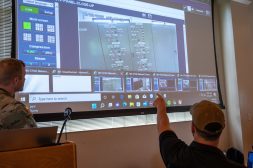DARPA previews video game-like cyber defense project
You don’t have to be a computer geek to use your PC.
So you shouldn’t need to be a tech guru to identify attacks with a real-time cyber warfare system, say officials with Plan X, an easy-to-use cybersecurity platform developed under the Defense Advanced Research Projects Agency.
“Everybody’s seen in the press where Cyber Command needs to hire 6,200 folks to man what they call the Cyber Mission Forces,” Frank Pound, director of Plan X, told an audience Thursday at a Christian Science Monitor event before giving a live demo of the system. “How are they going to do that with the current tool set that’s out there? Not everybody is a computer scientist, not everybody is a developer.”
DARPA’s answer to that question is building a futuristic interface for a cybersecurity system that uses gestures and motions as commands. It also uses graphics that help less-seasoned operators recognize attacks. In 2013, DARPA awarded the project to six contractors: Data Tactics Corp., Intific Inc., Raytheon SI Government Solutions, Aptima Inc., Apogee Research LLC and Northrop Grumman Corp.
“How do we get a cyber operations framework that’s useable by the military deployed so that they can begin to take control of their own networks and be able to reason about the networks, to remove that fear and uncertainty that exists now in cyber?” Pound said of how DARPA conceived the project.
“What we know and what we’ve learned with modern interfaces, like the iPhone and tablets, touch has become a native, intuitive interface where people are — kids, babies actually are — using these things effectively,” the project lead said. “So can we integrate touch into a cyber operations platform to allow junior analysts, young analysts, to start to reason about their networks, defend their networks, and understand and run analytics?”
Demo-ing third and most-recent prototype of the system, Pound was able to drag and drop a command into a timeline of events affecting one of the endpoints connected to his network. With his right arm in a cast, he was able to quickly and easily perform an action with his left hand, much like he was playing a video game. A later presenter commented on how it reminded him of young Matthew Broderick in “WarGames.”

A solider works on an earlier prototype of Plan X. (Defense.gov)
“Instead of looking at log files and looking at Internet data, take that a step up in the visualization standpoint, put that in a touch interface, put that in a graph, put that in different viewpoints so the user can begin to reason about it visually rather than having to understand what each one of these fields is,” Pound said of the Plan X interface. The idea is to make “something that catches the eye … something that users will natively understand,” he said. There’s also the possibility that DARPA could scale the project to virtual reality systems, like the Oculus Rift.
Making the operator’s job all that much easier, Plan X also uses a collaborative dimension, somewhat reminiscent of Apple’s App Store. So when Pound deployed his code, he didn’t even have to write it. He just pulled it from a central depository, which would be theoretically shared among all of the Defense Department.
“Every DOD enclave, every tactical operations center, will have a Plan X interface,” Pound said. “Operators across the globe will be able to collaborate when they see attacks,” sharing code they’ve written in the past for similar types of attacks to respond almost instantaneously.
With the interface and tools needed in place, Pound said the hope is “that an E-4 in the Army could actually start to accomplish this mission as well.” Building a 6,200-soldier Cyber Mission Force immediately looks a lot easier if the same job can be done by normal soldiers using Plan X, he said. “The idea of requiring junior people in the military to, say, subnet IPv6 addresses is not really tenable. Some people are smart in some areas, and some people are smart in others. Not everybody is a computer geek.”





